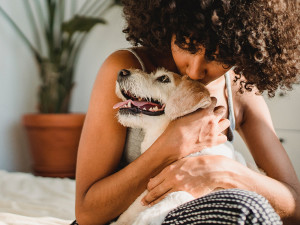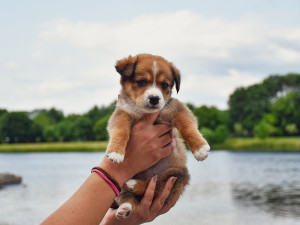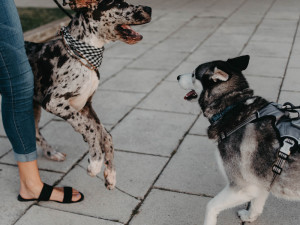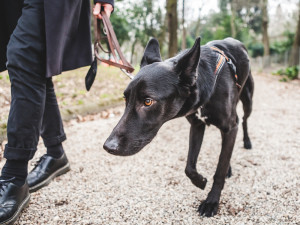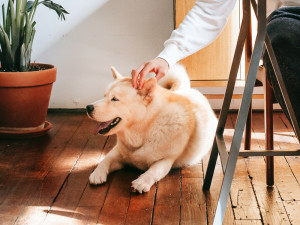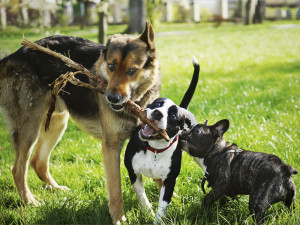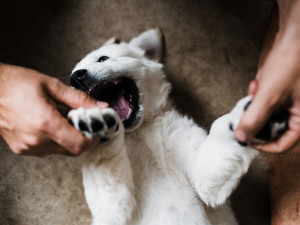Here’s Why Your Dog Is Terrified of New People
And how to change it
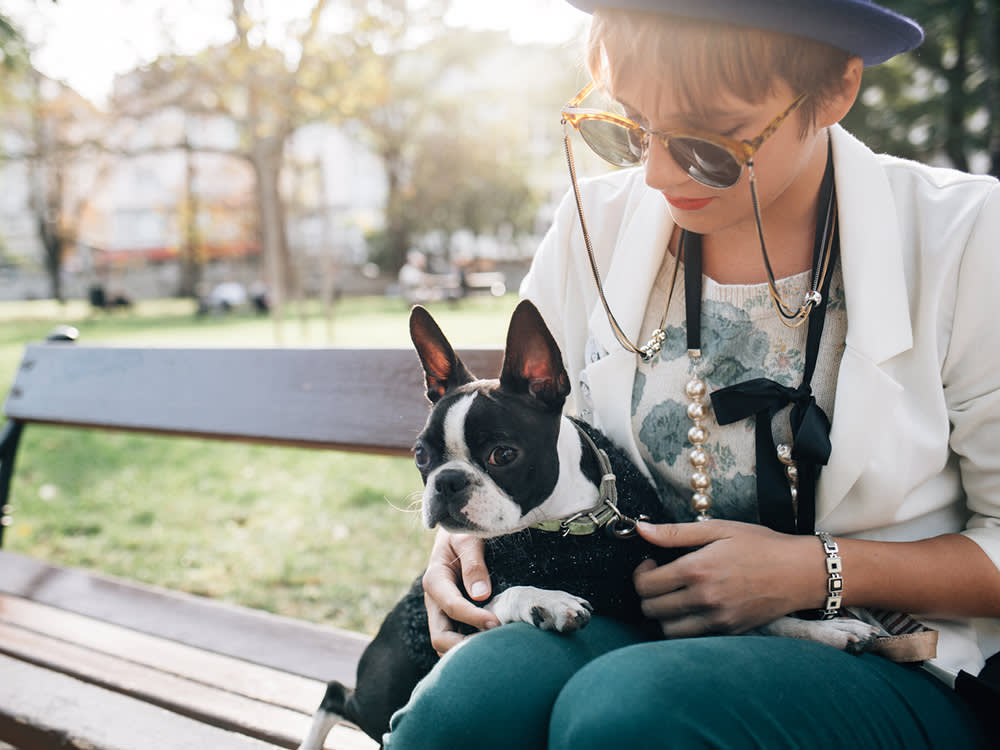
Share Article
Since you were a little kid, you’ve been told about ‘stranger danger’. Don’t go up to anyone you don’t know, stay with your assigned partner on a school trip and maintain a healthy level of suspicion of people you don’t know at all times. Guess what? Some dogs – not all – also have one metaphorical eyebrow arched when it comes to new people.
Dogs who are super-sweet and friendly with people they know but act completely differently with people they don’t know are probably in that stranger danger zone. It’s common for dogs to divide people into those who are familiar and those who are unfamiliar. Many dogs are perfectly happy to be around unfamiliar people and make friends quickly.
But there are lots of dogs who are not easily able to make friends, and the unfamiliar people they see or come into contact with cause a lot of stress. These dogs do not easily make new friends, and anyone unfamiliar tends to stay in that category without a lot of work to help them cross the boundary into the familiar group. Dogs like these are said to have stranger danger – and it can be quite common in dogs, in part because there are multiple reasons for it.
What are the causes of stranger danger?
There are three main reasons why dogs struggle to be comfortable around people they don’t know — genetics, inadequate socialisation and trauma. For any dog with stranger danger, at least one of these is probably an issue, but many dogs can have more than one or even all three of these in their history.
Genes
Genetics play a huge role in how accepting dogs are of anything or anyone unfamiliar. Some dogs are just naturally wired to be wary of anything new, and some dogs have the opposite natural tendency, meaning they easily accept the unfamiliar. Genetic characteristics alone do not determine how fearful dogs are or how easily they are able to adjust to new people, but genes are important.
A dog’s genetic history influences the likelihood of being fearful of strangers, but there is a lot of variation because of the way their life experiences affect how they turn out. A tendency towards fearfulness, and therefore to stranger danger, is heritable, meaning that it tends to be passed down from parents to their puppies. Puppies who come from shy and fearful parents are more likely to be shy and fearful themselves, and there are entire lineages of dogs that are characterised by fearfulness towards people and trouble accepting new people.
Not enough proper socialisation
Inadequate socialisation is a major cause of stranger danger, which is why dog trainers and canine behaviourists are always encouraging people to socialise their dogs. Socialisation is actually a technical term, but it is often used casually to mean being social, which is confusing. I’m using it here in its full scientific glory to mean something very specific: to expose a puppy to a variety of new experiences during a critical period of their lives.
The critical period for puppy socialisation starts at about three weeks of age and lasts until they are about 14 weeks of age. During this specific time of life, which can also be called a sensitive period, puppies are extra receptive to learning that new things are not scary. Meeting just a few people and having positive experiences with them at this young age allows them to learn effortlessly that people are good and not to be feared. If they do not learn this lesson during this time, they may be able to learn it later on, but it takes far more effort, far more work and may not ever be learned as completely as if they had these good exposures at the right age.
Learning these social lessons about people (and about cats, or other dogs, or even ferrets and other animals in the home) can be compared to learning a language. Yes, you can learn a language at any age, but if you learn it as a child, you will be a native speaker or at least a highly skilled speaker – but you are extremely unlikely to develop that degree of proficiency with languages that you learn when you are older. That’s because people have a critical or sensitive period for language acquisition, just as puppies have a window of time for the acquisition of social skills, including being comfortable with strangers. A great book for this is Puppy Socialization: What It Is and How to Do Itopens in new tab by Marge Rogers and Eileen Anderson.
Traumatic experiences
Trauma can cause a dog to be afraid of strangers. If a dog somehow associates people with a terrible situation, such as being in serious pain or really frightened, they may develop stranger danger. Terrible experiences can range from a long history of abuse by people or a single experience that is upsetting. Those experiences can be as simple as seeing a new person right as a door slams. The loud sound can scare the dog, who associates the fear with the person who just happens to be standing there – wrong place, wrong time.
I have known dogs whose stranger danger developed after a painful medical procedure or an injury. One dog I knew got stuck in a fence and got injured as a result. Even though a kind passerby helped save the dog, he still became terrified of new people, probably because the worst moment of his life involved a new person. That new person was the good guy, but the dog didn’t view it that way.
Tragically, there are people who abuse dogs, and dogs in those abusive situations often continue to fear people even once they are living with kind people and only meeting good people. The fear of what people can do doesn’t go away just because the abuser is gone. The trauma remains. Sometimes, people assume that a dog with stranger danger was abused, and though that is sometimes the case, it is far more common that the dog was poorly socialised or is just naturally fearful because of their genetics. No amount of abuse is acceptable, but it sometimes helps me cope to remember that it’s rare.
What are the signs that your dog has stranger danger?
Dogs who are fearful of people frequently express their fear through their behaviour, including their body language. Recognising fearfulness in dogs requires knowledge and experience. Here are some of the common signs.
Looking smaller
Dogs who are afraid tend to make their body look smaller. They may do this by crouching close to the ground, lowering their head, putting their ears back, lowering or even tucking their tail and rounding their back.
Specific behavioural clues
When frightened, dogs may close their mouths, pull the corners of their mouths back, flick their tongues, furrow their brows, yawn or dilate their pupils. Some fearful dogs tremble, pant, drool or sweat through their feet and leave paw prints as they walk. Pacing and being unable to settle are clues your dog may be fearful. There are fearful dogs who whimper and whine, but others may growl and bark. Some may run away and hide when they see a stranger.
Types of people typical fearful dogs are afraid of
Fearful dogs are afraid of unfamiliar people but are far better with people they know. Most fearful dogs are more afraid of men than of women, especially if those men are tall, have a deep voice or are sporting a beard. People carrying things such as a backpack, shopping bags, a chair, garden tools or a broom, or even a clipboard are more likely to upset fearful dogs, as are people who are wearing sunglasses, hats or full masks like those used for Halloween. (Curiously, surgical masks rarely upset dogs, which was an interesting fact many behaviourists and trainers learned early on in the pandemic.)
Patterns of aggression caused by fear
If a fearful dog is also aggressive, they may follow a typical pattern. Fearful, aggressive dogs may act out more towards strangers when they are with close family members, and if they do bite, it’s especially common for them to do so when somebody reaches for them or tries to stroke them, surprises them by seemingly appearing out of nowhere, or when the person turns around and has their back facing the dog.
How can you help a dog with stranger danger?
Helping dogs with stranger danger involves patience, a gentle approach, lots of compassion and perhaps seeking the help of a professional dog behaviourist. These people have the education, knowledge and experience necessary to help fearful dogs. There are two basic ways to help dogs overcome their fear of strangers.
Protect your dog from situations with strangers they can’t handle
If your dog is scared of a person, don’t force the issue. Never push them to approach a person they fear or encourage the person to approach your dog. Trying to teach them not to fear people by showing them that nothing bad happens is ineffective because to them, something bad did happen. The bad thing is that they felt fear. So, every time you push them to interact with or approach strangers, they have a bad experience, and that only makes the stranger danger worse. So instead of pushing the dog, avoid situations that are overwhelming, and protect your dog from people who scare them. Even if you see no reason why your dog should be afraid of someone, respect their feelings and keep your dog out of situations with strangers who scare them.
Expand the range of situations with strangers that your dog can handle
Overcoming the fear of strangers requires changing the emotional response of your dog to seeing unfamiliar people, and that can be accomplished with classical counterconditioning, or CC. CC is pairing up what the dog fears with something they love, such as chicken or steak, but the feared things (strangers) must be presented at very low intensity. In fact, the intensity must be too low to trigger the fear. A person who is very far away or who is sitting down may be below the threshold, for example.
Certainly, one person at a time is easier to handle than multiple people. The goal is to pair up a stranger with treats enough times for the dog to learn that strangers predict something delicious. With enough repetition, the dog learns to feel happy about seeing strangers because they come to expect a treat. Then, the intensity can gradually be increased until the dog is happy to see strangers at closer and closer distances, or when two strangers appear instead of just one. The goal is for the dog to have a positive emotional reaction to seeing a person, because they know that something good is about to happen.
If your dog has stranger danger, it’s important to know that it is common and that it is an issue that can be improved. Many people have successfully helped their dogs overcome this fear, and you can, too.

Karen B. London, PhD, CAAB, CPDT-KA
Karen B. London, Ph.D., is a Certified Applied Animal Behaviorist and Certified Professional Dog Trainer who specializes in working with dogs with serious behavioral issues, including aggression, and has also trained other animals including cats, birds, snakes, and insects.
Related articles
![Unrecognizable man sitting at desk petting his dog]()
How to Stroke a Dog – Yes, You Do Need Lessons
There’s a difference between being affectionate and being annoying
![Three dogs biting a stick.]()
Some Like It Rough: Playing vs Fighting
Two animal behaviour experts agree that it’s usually play fighting. Here’s how you can tell
![Golden retriever puppy upside down playing with a mans hands and attempting to play bite.]()
How to Stop Puppy Biting: Training Your Puppy
Because bite marks are not a good look
![Owner serving dog food]()
Your Dog’s Food Aggression Isn’t Cute – Here’s How You Can Work On It
No longer associate feeding time with growling time
![Great Dane puppy and Husky meeting on leash out side.]()
Understanding Reactivity and Aggression in Dogs: Two Very Different Things
Apparently even experts have a hard time defining these terms


